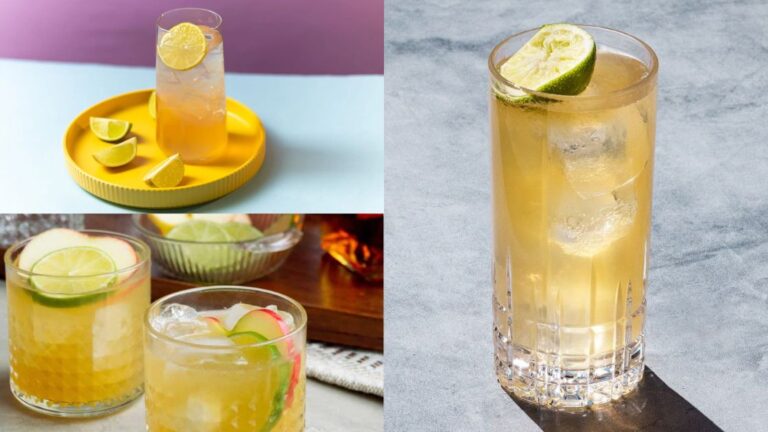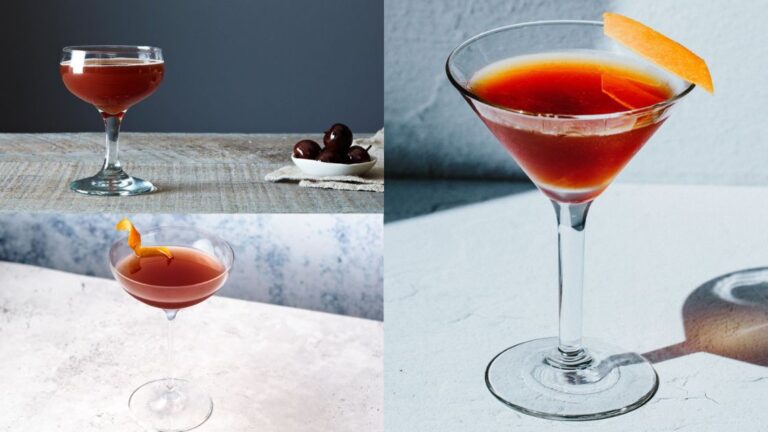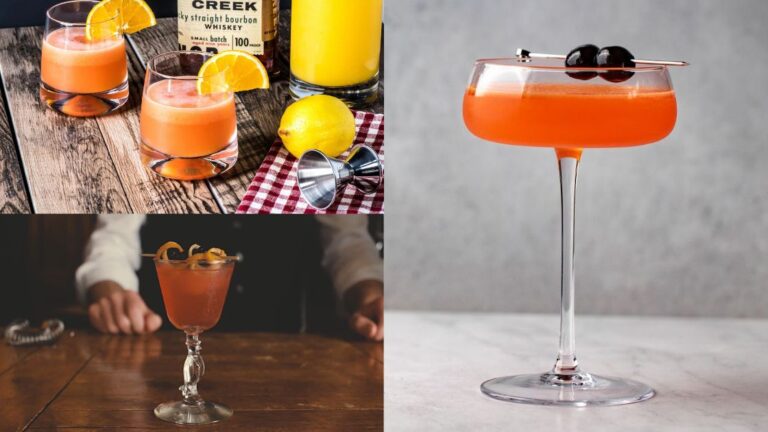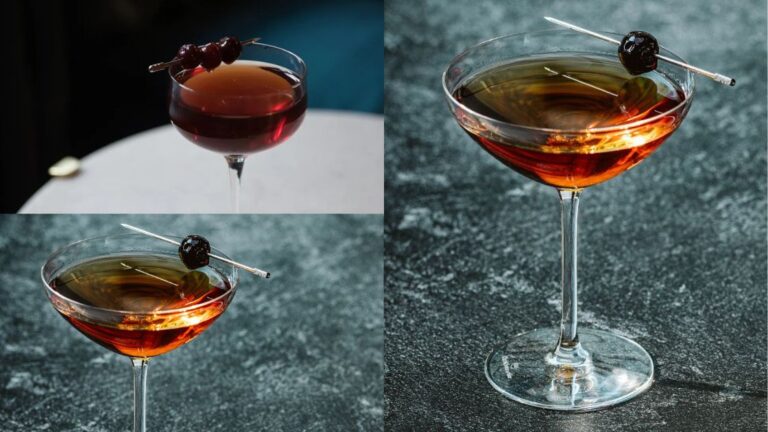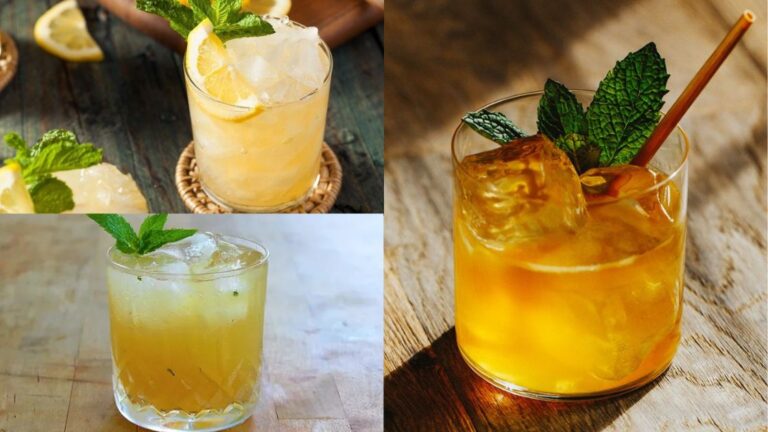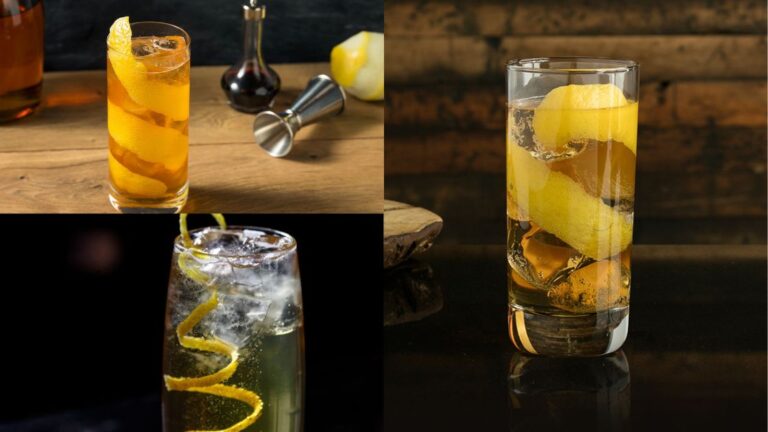Bourbon whiskey, or simply “bourbon,” isn’t just a drink – it’s an icon. Appreciated in every corner of the world, this iconic spirit is beloved for its smooth and slightly sweet depth of flavor. Crafted primarily from corn and matured in charred new oak barrels, bourbon boasts a unique flavor that sets it apart from all other whiskeys. Whether you prefer it neat, on the rocks, or as the shining star in a classic cocktail like the Old Fashioned or Mint Julep, there’s no denying bourbon’s unique charm and versatility.
Bourbon isn’t just a drink, it’s a chapter in the great American narrative. It came to life in the late 18th century as a spirit of the frontier before earning its place on the global stage as a drink that commands respect. Over the years it’s been a rebel’s symbol, a casualty of prohibition, an economic game-changer, and a testament to American craftsmanship and tradition.
The tale of bourbon is woven into the American story, its name echoing Bourbon County, Kentucky. Today it’s more than a beverage, it’s a crucial thread in the tapestry of American culture. Congress even recognized it as “America’s Native Spirit,” and laws protect its unique identity and quality. Stick around as we journey further into the world of bourbon whiskey, exploring what sets it apart, its historical trajectory, the rigorous rules of its production, and the subtle flavors that make it a cherished spirit across the globe.
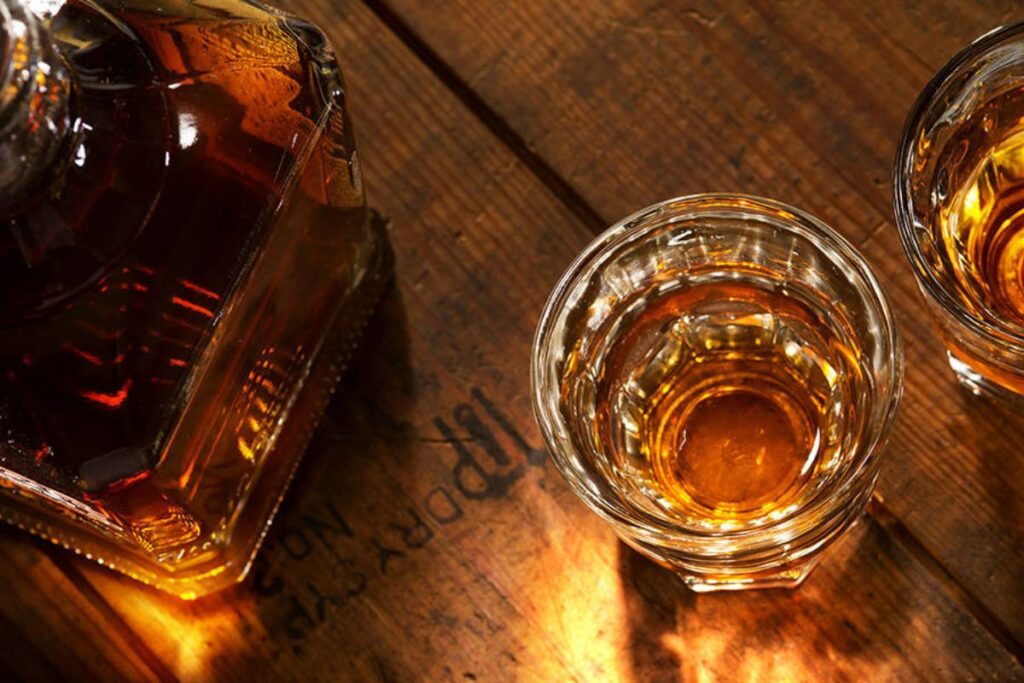
History of Bourbon Whiskey
Origin and Early Development
The origin of bourbon whiskey is steeped in American history. While it’s difficult to pinpoint an exact creator, the process of distilling grain mash likely came over from European settlers in the 18th century. The practice then evolved within the resource-rich, corn-abundant frontier lands of Kentucky, which offered an optimal environment for bourbon production. The limestone-rich waters of the region played a significant role in shaping bourbon’s distinctive taste. By the late 18th century, this whiskey-making tradition, further refined by the use of charred oak barrels for aging, started taking the form of what we recognize today as bourbon.
The Role of Bourbon in American History
Bourbon whiskey has been a silent participant in several historical events in America. During the Whiskey Rebellion in the 1790s, it indirectly supported the strengthening of the newly formed federal government when President Washington enforced excise tax laws on spirits.
With the advent of Prohibition in the 1920s, the bourbon industry faced a significant setback. Despite being mostly banned, some distilleries in Kentucky were permitted to continue production for “medicinal purposes,” allowing bourbon to survive this challenging era. Following the repeal of Prohibition in 1933 the bourbon industry began a slow recovery. Gradually the bourbon industry regaining its status as an American staple.
Growth and Evolution of the Bourbon Industry
Post-Prohibition, the bourbon industry underwent significant changes. Innovations in production methods and marketing tactics, coupled with the changing taste preferences of the public, led to the rise of new bourbon styles. Following World War II, bourbon’s popularity soared, both domestically and internationally.
In recent decades, the bourbon industry has seen a renewed growth and a “premiumization” trend, with more emphasis on small batch and single barrel offerings. As of the early 21st century, bourbon has been in a “Golden Age,” with global demand skyrocketing and bourbon tourism becoming a significant economic contributor in places like Kentucky. The industry has grown into a multi-billion dollar enterprise. Thus, embodying the entrepreneurial spirit and craftsmanship that has defined America from its earliest days.
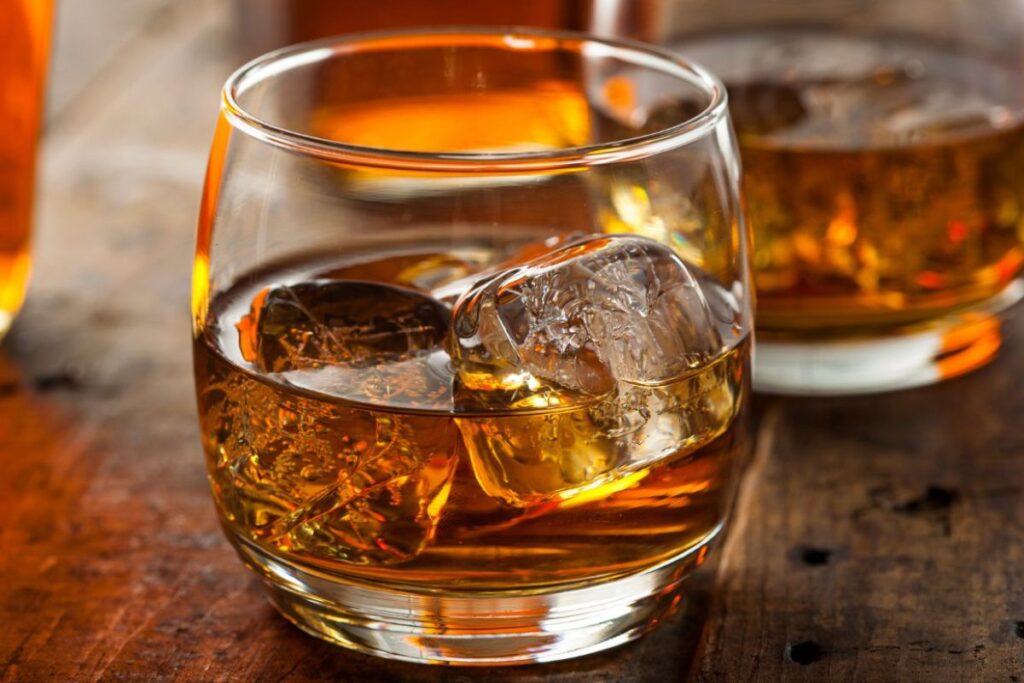
What Makes a Whiskey a Bourbon
Explanation of the Federal Standards of Identity for Distilled Spirits
The production of bourbon is governed by a strict set of federal regulations, often referred to as the Federal Standards of Identity for Distilled Spirits. These rules define what can legally be called bourbon in the United States:
- Made in the U.S.: Bourbon whiskey must be produced within the borders of the United States. This doesn’t mean it has to be made in Kentucky, though the majority of bourbon is produced there.
- Made from a grain mixture that’s at least 51% corn: The grain mash from which bourbon is distilled must be composed of at least 51% corn. The remainder typically consists of barley, rye, or wheat.
- Aged in new, charred oak containers: After distillation, the liquid must be aged in new containers made from American Oak, charred on the inside. There is no specified minimum aging period to be termed bourbon, but to be labeled as “straight” bourbon, it must be aged for at least two years.
- Distilled to no more than 160 proof (80% alcohol by volume): The distillation process must not exceed 160 proof to preserve the natural flavors derived from the grains.
- Entered into the container for aging at no more than 125 proof (62.5% alcohol by volume): This is to ensure that the bourbon does not become overly alcoholic and retains its characteristic flavors during aging.
- Bottled at 80 proof or more (40% alcohol by volume): Finally, bourbon must be bottled at no less than 80 proof to maintain a robust and complex flavor profile.
Discussing Why These Requirements are in Place
These standards were put into place to maintain the integrity and identity of bourbon as a uniquely American product, much like Champagne in France or Tequila in Mexico. They ensure consistency, quality, and distinctive characteristics that bourbon enthusiasts have come to appreciate.
The use of at least 51% corn, for example, gives bourbon its classic sweet and full-bodied flavor. The requirement for new charred oak barrels for aging imparts the amber color, as well as vanilla and caramel notes, to the spirit. The distillation proof and bottling strength requirements are designed to balance the alcohol content with the natural flavors and aromas of the grains and the wood. All these rules combined make bourbon an exceptional and distinctive category of whiskey.
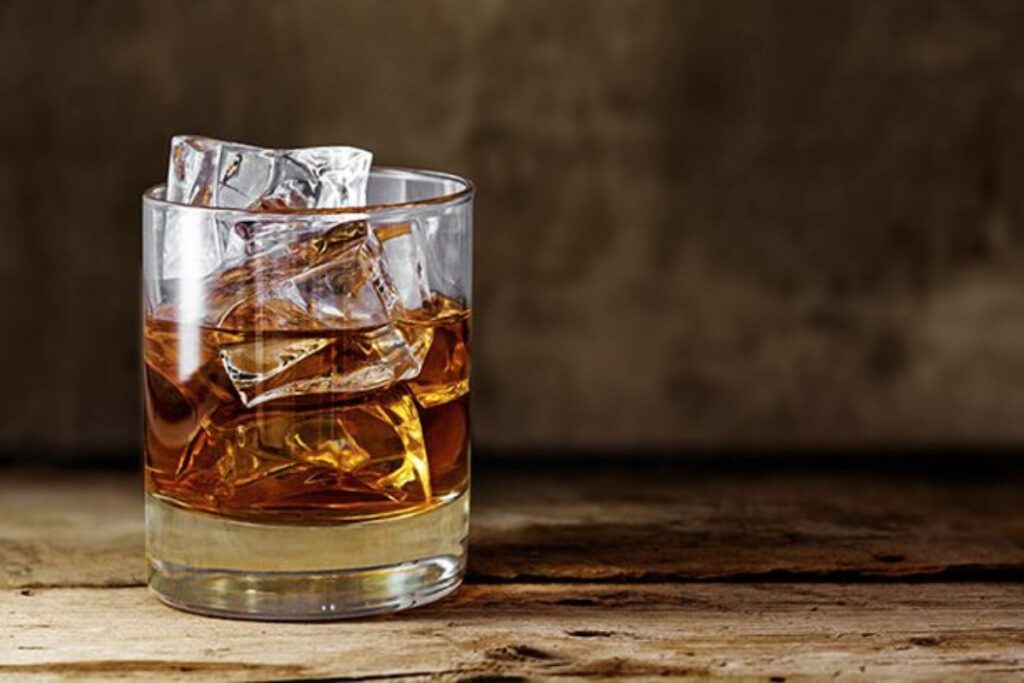
The Bourbon Production Process
Overview of the Distillation Process
The production of bourbon starts with a grain mix, with at least 51% corn, and usually supplemented by rye, barley, and sometimes wheat. These grains are ground into a coarse meal, mixed with water, and heated to convert the grain starches into fermentable sugars. Next, a portion of a previously fermented mash (known as sour mash) is added to ensure consistency across batches. Then, yeast is introduced to start the fermentation process, turning the sugars into alcohol. This mixture, now called the “wash,” is then distilled. The wash is heated in a still, where the alcohol evaporates, is collected and then cooled to create a high-proof liquid known as “white dog” or “new make,” the clear spirit before it is aged in barrels.
Aging Process
After distillation, the white dog is transferred into new, charred oak barrels for aging. During this time, the bourbon undergoes a series of chemical reactions. This reaction contributes significantly to its flavor, color, and aroma. The spirit absorbs elements from the charred wood, imparting the distinct caramel and vanilla notes characteristic of bourbon whiskey. While there’s no set aging period for bourbon, it must be aged for at least two years to be classified as ‘straight’ bourbon. However, most premium bourbons are aged between four to twelve years or more.
Importance and Role of Charred Oak Barrels
Charred oak barrels play a crucial role in the bourbon-making process. The charring process caramelizes the sugars in the wood, which imparts both flavor and color to the bourbon as it ages. The barrels’ interior surface interacts with the distilled spirit, smoothing the harsh alcoholic edge and developing complex flavors and a rich amber color over time. Additionally, the seasonal changes in temperature cause the bourbon to expand and contract within the barrel, allowing it to further interact with the wood. The use of new barrels for each batch ensures that these flavors will be strong and consistent in every bottle of bourbon.
Bottling Process
Once the bourbon has aged to the distiller’s satisfaction, it’s removed from the barrels – a process known as “dumping” – and is typically filtered to remove any wood fragments. It may be diluted with water to reach the desired proof before bottling. It’s worth noting that “barrel-proof” or “cask-strength” bourbons are bottled at the proof they reach in the barrel, offering a more intense flavor experience. The final product is then bottled, labeled, and prepared for distribution and sale.
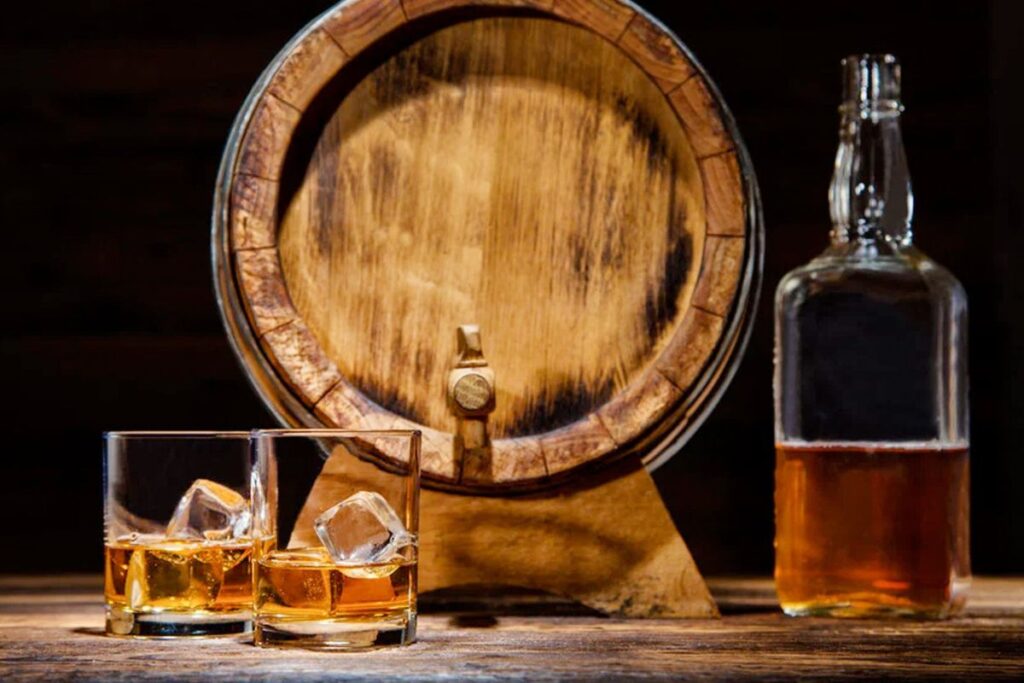
Different Types of Bourbon Whiskey
Traditional Bourbons
Traditional bourbons usually consist of a grain mixture that is 70-75% corn, 15-20% rye, and the remainder being malted barley. Brands such as Jim Beam and Wild Turkey produce this style, which often boasts a balanced and well-rounded flavor profile with a mix of sweetness from the corn and spiciness from the rye.
High-Rye Bourbons
High-rye bourbons have a higher percentage of rye in the grain mixture, typically above 20%. This gives the bourbon a spicier and more robust flavor compared to traditional bourbons. Brands like Bulleit and Four Roses are well-known for producing high-rye bourbons.
High-Wheat Bourbons
High-wheat bourbons, also known as “wheated bourbons,” replace the rye in the grain mixture with wheat. This results in a smoother and sweeter bourbon, as wheat doesn’t contribute the spiciness that rye does. Maker’s Mark and Pappy Van Winkle are notable brands that produce high-wheat bourbons.
Single-Barrel Bourbons
Single-barrel bourbons, as the name suggests, are bottles that are filled from a single barrel of bourbon. This allows for unique flavor profiles that show the subtle variations between individual barrels. These are often higher-end, with brands like Blanton’s and Four Roses Single Barrel leading the pack.
Small Batch Bourbons
Small batch bourbons are made by blending a select number of barrels (the term “small batch” doesn’t have a legal definition, but the general consensus is fewer barrels than mass-market bourbons). This type is often smoother and more complex due to the blending of multiple barrels. Notable brands include Booker’s, Knob Creek, and Woodford Reserve.
Brief Notes on How Each Type Differs in Taste and Production
As evident from above, the different types of bourbon have varying flavor profiles, primarily depending on the grain mixture used in the mash. Traditional bourbons offer a balanced taste, high-rye bourbons bring a spicier kick, while high-wheat bourbons are known for their smoothness.
In terms of production, all types follow the same basic process. However, for single-barrel bourbons, each bottle comes from one specific barrel, offering unique, unblended flavor profiles. For small batch bourbons, the distiller selectively blends a few barrels to achieve a specific flavor profile. This diversity in taste and production methods allows bourbon enthusiasts to explore and appreciate a wide range of experiences within the world of bourbon whiskey.
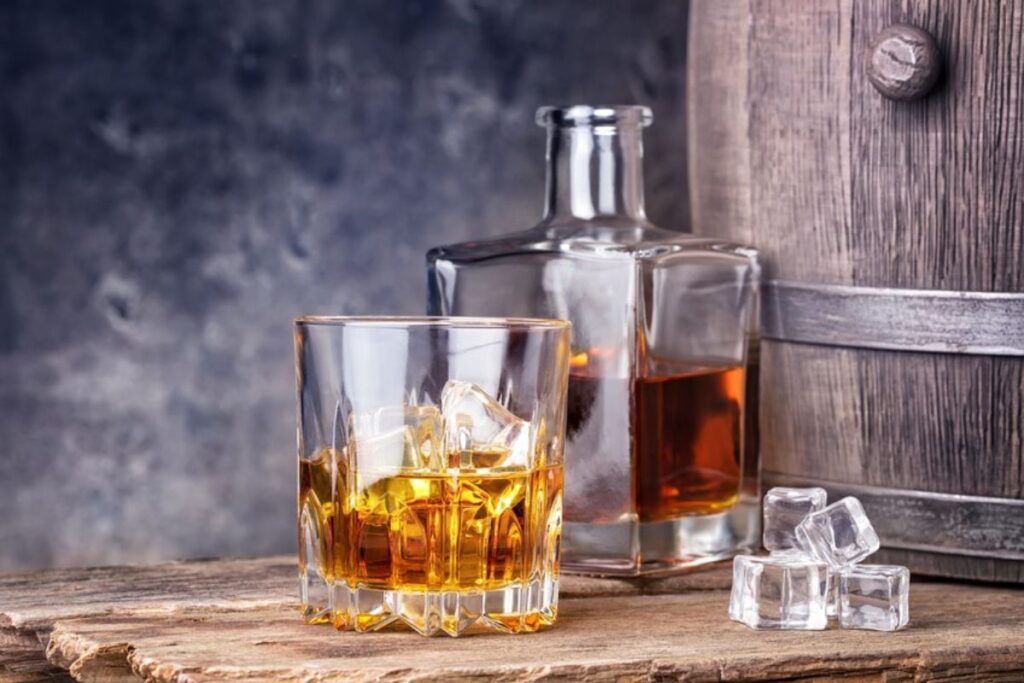
Tasting Bourbon
How to Taste Bourbon Like a Pro
Tasting bourbon involves more than simply drinking it. It’s about appreciating the sensory experiences that come with each sip:
- Sight: Observe the color of the bourbon. A deeper color often indicates a longer aging period.
- Smell: Swirl the bourbon gently and take a sniff. Try to identify different notes – they could range from sweet caramel and vanilla to spicy rye, oak wood, fruits, or nuts.
- Taste: Take a sip and let it sit in your mouth. Let it cover your tongue and taste buds. Try to identify the flavors – is it sweet, spicy, fruity, or nutty?
- Finish: Swallow the bourbon and pay attention to the aftertaste, also known as the finish. A good bourbon usually has a long, warming, and pleasant finish.
Importance of Water and/or Ice in Bourbon Tasting
Adding a few drops of water or a small ice cube can open up the flavors of bourbon, especially for higher proof ones. The water can tone down the alcohol burn and allow you to better taste the underlying flavors. However, too much water or ice might dilute the flavors. The choice is personal and depends on one’s preference.
Popular Food Pairings with Bourbon
Bourbon pairs wonderfully with a wide variety of foods due to its rich and complex flavor profile. Here are some popular food pairings:
- Barbecue: The smoky flavors of grilled meats complement the sweet, rich, and smoky notes in bourbon.
- Chocolate: Dark chocolate and bourbon is a classic pairing. The rich, sweet flavors of both can complement each other nicely.
- Cheese: Aged cheddar, blue cheese, or gouda can stand up to the strong flavors of bourbon.
- Nuts and dried fruits: Almonds, walnuts, apricots, and figs can bring out the fruity and nutty notes in bourbon.
- Spicy Foods: The sweetness of bourbon can balance out spicy flavors, making for an interesting pairing.
By learning to appreciate the different aspects of bourbon and understanding its versatility in pairings, you can enhance your overall enjoyment of this classic American spirit.
Conclusion
Bourbon is more than just a spirit, it’s a reflection of American history, craftsmanship, and tradition. Defined by a strict set of regulations, bourbon distinguishes itself with its rich, full-bodied flavor profile, primarily derived from its 51% corn content and the crucial aging process in new, charred oak barrels. The bourbon universe is broad and diverse, offering different styles from traditional to high-rye or high-wheat bourbons, to single-barrel and small-batch varieties. Each style comes with its unique characteristics, inviting bourbon enthusiasts to a world filled with flavors waiting to be explored.
As you step into the world of bourbon, remember that tasting bourbon is an experience. Bourbon whiskey engages sight, smell, and taste, and no two bourbons are exactly the same. Whether you enjoy it neat, on the rocks, with a splash of water, or in a classic cocktail, the versatility of bourbon makes it a fascinating spirit to appreciate. So, raise a glass, take a sip, and savor the complexities and nuances that bourbon has to offer.
